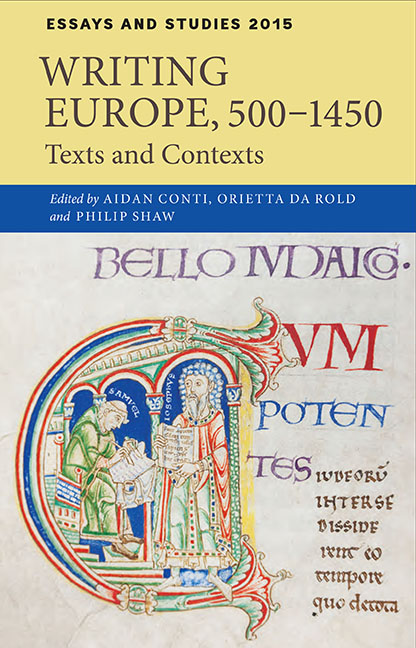16 results
17 - Philological Approaches
- from Part IV - Empirical Approaches
-
-
- Book:
- The Cambridge Handbook of Historical Orthography
- Published online:
- 28 September 2023
- Print publication:
- 12 October 2023, pp 338-359
-
- Chapter
- Export citation
Death in delirious palliative-care patients occurs irrespective of age: A prospective, observational cohort study of 229 delirious palliative-care patients – CORRIGENDUM
-
- Journal:
- Palliative & Supportive Care / Volume 19 / Issue 3 / June 2021
- Published online by Cambridge University Press:
- 20 May 2021, p. 393
-
- Article
-
- You have access
- HTML
- Export citation
Delirium is associated with an increased morbidity and in-hospital mortality in cancer patients: Results from a prospective cohort study
-
- Journal:
- Palliative & Supportive Care / Volume 19 / Issue 3 / June 2021
- Published online by Cambridge University Press:
- 12 January 2021, pp. 294-303
-
- Article
-
- You have access
- Open access
- HTML
- Export citation
The prevalence rates and sequelae of delirium at age older than 90 years
-
- Journal:
- Palliative & Supportive Care / Volume 19 / Issue 5 / October 2021
- Published online by Cambridge University Press:
- 07 December 2020, pp. 552-557
-
- Article
- Export citation
Death in delirious palliative-care patients occurs irrespective of age: A prospective, observational cohort study of 229 delirious palliative-care patients
-
- Journal:
- Palliative & Supportive Care / Volume 19 / Issue 3 / June 2021
- Published online by Cambridge University Press:
- 15 September 2020, pp. 274-282
-
- Article
- Export citation
Predisposing and precipitating risk factors for delirium in palliative care patients
-
- Journal:
- Palliative & Supportive Care / Volume 18 / Issue 4 / August 2020
- Published online by Cambridge University Press:
- 14 November 2019, pp. 437-446
-
- Article
- Export citation
Thyroid cancer has a small impact on patient–partner relationships and their frequency of sexual activity
-
- Journal:
- Palliative & Supportive Care / Volume 16 / Issue 3 / June 2018
- Published online by Cambridge University Press:
- 31 May 2017, pp. 335-346
-
- Article
- Export citation
Frontmatter
-
- Book:
- Writing Europe, 500-1450
- Published by:
- Boydell & Brewer
- Published online:
- 11 June 2021
- Print publication:
- 15 October 2015, pp i-iv
-
- Chapter
- Export citation
Contents
-
- Book:
- Writing Europe, 500-1450
- Published by:
- Boydell & Brewer
- Published online:
- 11 June 2021
- Print publication:
- 15 October 2015, pp v-vi
-
- Chapter
- Export citation
Notes on Contributors
-
- Book:
- Writing Europe, 500-1450
- Published by:
- Boydell & Brewer
- Published online:
- 11 June 2021
- Print publication:
- 15 October 2015, pp ix-xii
-
- Chapter
- Export citation
Index
-
- Book:
- Writing Europe, 500-1450
- Published by:
- Boydell & Brewer
- Published online:
- 11 June 2021
- Print publication:
- 15 October 2015, pp 191-198
-
- Chapter
- Export citation
List of Abbreviations
-
- Book:
- Writing Europe, 500-1450
- Published by:
- Boydell & Brewer
- Published online:
- 11 June 2021
- Print publication:
- 15 October 2015, pp xviii-xviii
-
- Chapter
- Export citation
List of Illustrations
-
- Book:
- Writing Europe, 500-1450
- Published by:
- Boydell & Brewer
- Published online:
- 11 June 2021
- Print publication:
- 15 October 2015, pp vii-viii
-
- Chapter
- Export citation
Acknowledgments
-
- Book:
- Writing Europe, 500-1450
- Published by:
- Boydell & Brewer
- Published online:
- 11 June 2021
- Print publication:
- 15 October 2015, pp xvii-xvii
-
- Chapter
- Export citation
Writing the Germanic Languages: The Early History of the Digraphs <th>, <ch> and <uu>
-
-
- Book:
- Writing Europe, 500-1450
- Published by:
- Boydell & Brewer
- Published online:
- 11 June 2021
- Print publication:
- 15 October 2015, pp 101-122
-
- Chapter
- Export citation

Writing Europe, 500-1450
- Texts and Contexts
-
- Published by:
- Boydell & Brewer
- Published online:
- 11 June 2021
- Print publication:
- 15 October 2015



